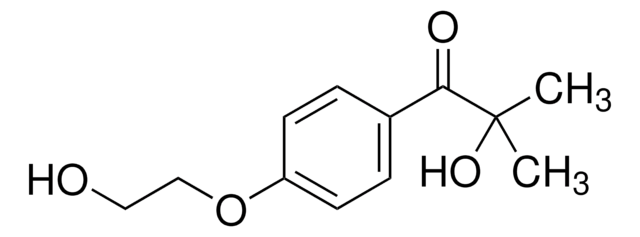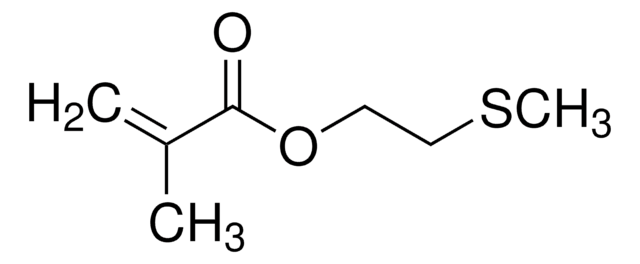735094
Bis(2-methacryloyl)oxyethyl disulfide
contains ≤6000 ppm hydroquinone as stabilizer
Sinónimos:
DSDMA, Disulfide-based dimethacrylate
Iniciar sesiónpara Ver la Fijación de precios por contrato y de la organización
About This Item
Fórmula empírica (notación de Hill):
C12H18O4S2
Número de CAS:
Peso molecular:
290.40
Número MDL:
Código UNSPSC:
12162002
ID de la sustancia en PubChem:
NACRES:
NA.23
Productos recomendados
formulario
liquid
contiene
≤6000 ppm hydroquinone as stabilizer
índice de refracción
n20/D 1.517
densidad
1.141 g/mL at 25 °C
temp. de almacenamiento
2-8°C
cadena SMILES
CC(=C)C(=O)OCCSSCCOC(=O)C(C)=C
InChI
1S/C12H18O4S2/c1-9(2)11(13)15-5-7-17-18-8-6-16-12(14)10(3)4/h1,3,5-8H2,2,4H3
Clave InChI
CGDNFXSLPGLMHK-UHFFFAOYSA-N
Categorías relacionadas
Descripción general
Bis(2-methacryloyl)oxyethyl disulfide (DSDMA) belongs to the class of monomers known as disulfide-based dimethacrylates. It is widely employed as a crosslinker in the synthesis of various polymers with specific properties such as redox sensitivity and self-healing properties. DSDMA contains a disulfide bond, which can be cleaved under specific conditions, making it useful for drug delivery systems. It also undergoes thiol-disulfide exchange reactions, allowing it to react with thiols in polymers and form covalent crosslinks. This property enables the formation of networks and gels in polymer systems. Additionally, DSDMA is employed in the development of biomedical materials, such as tissue engineering scaffolds. Its ability to form stable crosslinks in biological environments makes it suitable for these applications.
Aplicación
Bis(2-methacryloyl)oxyethyl disulfide (DSDMA) can be used in the following applications:
- Used as a crosslinker in the synthesis of reduction-responsive molecularly imprinted polymer (MIPs) nanogels for drug delivery applications. This reduction-responsive property allows for control over drug delivery and modulation of the release properties of the MIPs.
- Used as a crosslinker in the synthesis of self-healing polymer nanocomposites via dynamic disulfide exchange reaction and crosslinking properties. These self-healing polymer nanocomposites can be used in coatings, electronics, and packaging applications.
- Used as a redox-responsive cross-linker in the synthesis of zwitterionic hydrogels for effective drug delivery. DSDMA provides structural stability, redox-responsiveness, and self-healing properties, which are essential for effective drug delivery.
Frases de peligro
Consejos de prudencia
Clasificaciones de peligro
Aquatic Chronic 2
Código de clase de almacenamiento
10 - Combustible liquids
Clase de riesgo para el agua (WGK)
WGK 3
Punto de inflamabilidad (°F)
Not applicable
Punto de inflamabilidad (°C)
Not applicable
Elija entre una de las versiones más recientes:
¿Ya tiene este producto?
Encuentre la documentación para los productos que ha comprado recientemente en la Biblioteca de documentos.
Wenwen Li; Krzysztof Matyjaszewski; Krystyna Albrecht; Martin Moller
Macromolecules, 42, 8228-8228 (2009)
Kunihiko Kobayashi et al.
ACS applied materials & interfaces, 11(1), 151-159 (2018-12-12)
Soft-robotic devices such as polymeric microgrippers offer the possibility for pick and place of fragile biological cargo in hard-to-reach conduits with potential applications in drug delivery, minimally invasive surgery, and biomedical engineering. Previously, millimeter-sized self-folding thermomagnetically responsive soft grippers have
David S Spencer et al.
Journal of polymer science. Part A, Polymer chemistry, 56(14), 1536-1544 (2019-03-25)
Crosslinked cationic nanoscale networks with hydrophobic cores are an environmentally robust alternative to self-assembled polymeric drug delivery carriers with respect to therapeutic encapsulation and stability to dilution. However, the ability to tune the degree of PEG incorporated into nanogels during
Nuestro equipo de científicos tiene experiencia en todas las áreas de investigación: Ciencias de la vida, Ciencia de los materiales, Síntesis química, Cromatografía, Analítica y muchas otras.
Póngase en contacto con el Servicio técnico






